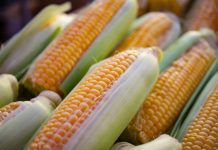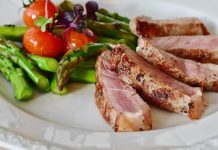Surimi is a ready-to-eat product that is flavored and colored to taste like whatever the intended final product is: crab, lobster, shrimp and other shellfish. If you have tasted imitation crabmeat, then you have tasted surimi. It has an almost-sweet flavor and the texture is smooth.
Imitation seafood can be found in different styles, such as molded, flaked or chunk-style. While the texture is smooth, cheaper varieties may have a distinct rubber-like texture.
Table of Contents
How Surimi Is Made
Surimi is made of ground up white-fleshed fish, with Alaskan pollock being a popular fish meat. Other fish varieties used for surimi meat include hake, cod, whiting and others. The white fish fillets are cleaned then ground or chopped with binder ingredients such as egg whites, starches or other stabilizers, depending on the brand. Other ingredients may include real seafood meat, for example king crab meat inside imitation crab meat.
The smooth fish paste then flavored and colored, and formed into different seafood shapes as required for packaging. The water and total fish content of surimi will depend on the brand.
Products Made of Surimi
Many products are made of surimi, and surimi can be processed to mimic actual seafood.
- Breaded items – Surimi can be formed into commercially breaded fish sticks and appetizer balls that need to be baked or fried before, using resulting in a crispy crust.
- Molded items or items made to look like the copied product – Such as imitation seafood (crab legs, lobster tails, whole shrimp, and scallops). They are generally ready-to-eat, and used when presentation is key, like in cold sushi hand rolls, vegetable salads, or in sandwiches.
- Flaked or chopped items, ready for use in the production of recipes – Surimi can be made into flaked or chopped imitation crab or lobster meat, or other pieces of fish. This can be used as is, or cooked in recipes.
- Pureed paste – Surimi product is used in fish tofu blocks, in commercial seafood wontons, and in fish cakes, spreads and balls.
Seafood surimi is also used in place of the real thing when supplies are tight and costs are high.
Using Surimi in Healthy Cooking
Surimi is low in cholesterol and very low in fat. A 3-oz. portion of surimi contains about a gram of fat and 26mg of cholesterol. Imitation seafood is a good source of Omega-3 fatty acids. The amount of fat, protein and cholesterol will depend on what the actual ingredients are inside the different surimi product, and if any other actual seafood meat was used in the mixture. For those on salt-restricted diets, check the label before purchasing for the actual sodium levels. Low-carb diets will need to check the total carb levels as well, since most imitation crab will contain different starches.



